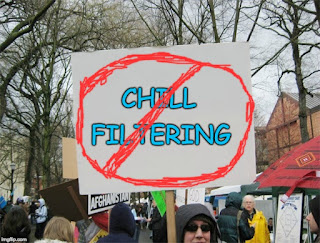Chill-Filtering Whisk(e)y
Recently, there was a big summit in Kentucky. Meeting were all the heavy hitter whisk(e)y
producers worldwide. The emergency
session came about to resolve the unexpected taxes and tariffs recently implemented
or that were imminent. Now, sure that’s
important stuff what with cost of booze to the consumer. After all, I’m a serious consumer. But why didn't they take advantage of the situation and discuss equally important issues - like putting an end to Chill Filtering!
Chill Filtering is a process that takes place just prior to
bottling, removing elements from the spirit that can make the whisk(e)y cloudy
when cooled via water, ice, refrigeration, etc.
Whisk(e)y makers don’t want customers being turned off by their product due
to cloudiness, so they’ve been utilizing this method for many, many years. And I get it - as a kid, I’d choose clear
apple juice over cloudy.
But here’s the thing: whisk(e)y drinkers aren’t 8 years old.
Flavor is not affected in the least. Moreover, the cloudiness goes away when
the whisk(e)y warms back up. And most
whiskies that would even need chill filtration are mixed with soda, so what’s
the point??
Actually, I have a better solution. Let’s just set the minimum alcohol by volume
(ABV) for whiskies at 46%. Chill Filtration is effective on whiskies with ABV
between 40-45%. However, those at 46% ABV
and higher do not benefit from the purely cosmetic process as the increased alcohol content is
enough to prevent cloudiness when cooled.
So, how did we get to the 40% minimum ABV, anyway? Basically,
an inexact science came up with the percentage for taxation purposes. Some sort of starting point was required, at some point, the United States settled on 40% for all distilled spirits. (See Code of Federal Regulations Title 27
Part 5).
Other countries, however, set their own standards, but for the most part, the bare minimum for a spirit to be called whisk(e)y is currently forty percent worldwide. One reason for this as cited by Charles MacLean in his the book on Scotch, Miscellany of Whisky, “is that there is a sharp falling off of aroma and flavour if it is bottled below forty percent.” That strikes me as random nonsense, but whatever. By that logic, if you add any water to your Dalmore 12, Redbreast 12, or Basil Hayden's (all 40% ABV), you will be in some sort of no-longer-whisk(e)y danger zone. Let Nature decide! And Nature's Forecast is...
* 46%+ Clear Skies with no chance of Cloudy *
 C'mon, whiskeymakers - you go to a lot of trouble creating beautiful concoctions and then storing
your spirit in oak casks for years! Why water it down… or rather “cut” it, to use industry vernacular, to the bare minimum required by
law?? We know what Stan from Chotchkie’s
would say.
C'mon, whiskeymakers - you go to a lot of trouble creating beautiful concoctions and then storing
your spirit in oak casks for years! Why water it down… or rather “cut” it, to use industry vernacular, to the bare minimum required by
law?? We know what Stan from Chotchkie’s
would say.
Some distilleries get it.
In 2007, Glenmorangie upped the ABV on all of their core whiskies from
43% to 46%. Springbank has been doing
the same thing for years. Suntory and Nikka
both experimented with Non-Chill Filtered (NCF) versions of some of their core
expressions, Hibiki 17 and Taketsuru 17 & 21, respectively. And while many cask strength bourbons are NCF,
definitely not all. Basically, the label
HAS to indicate “Non-Chill Filtered” to guarantee that it actually is NCF.
 |
| Labeled NCF |
 |
| Labeled UCF |
Another factor to take into account that not all Chill
Filtration processes are the same – they can vary from distillery to
distillery. Ugh. Just get rid of it all together, already! Contact your whisk(e)y representative today and demand an end to
Chill Filtration!!
Until then, check the ABV, check the label - support whiskeymakers who do the right thing! And once this chill filtering issue gets resolved, what say we tackle the caramel color additive? Looking at you, Scotland!
Until then, check the ABV, check the label - support whiskeymakers who do the right thing! And once this chill filtering issue gets resolved, what say we tackle the caramel color additive? Looking at you, Scotland!
Further Reading:
https://www.bourbonbanter.com/banter/ncf-nobody-checks-first/#.W025fNhKiu7
https://www.bruichladdich.com/faq/bruichladdichs-guide-chill-filtration/




No comments:
Post a Comment